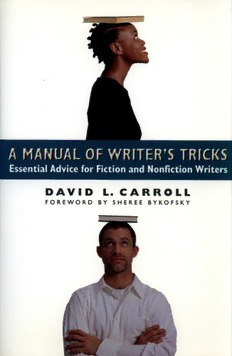
A Manual of Writers Tricks, David L. Carroll PDF
Preview A Manual of Writers Tricks, David L. Carroll
DAVID L. CARROLL FOREWORD BY SHEREE BYKOFSKY A MANUAL OF WRITER'S TRICKS A MANuAL OF WRITER'S TruCKS David L. Carroll MARLOWE & COMPANY New York Published by Marlowe & Company 841 Broadway, Fourth Floor New York, NY 10003 A MANUAL OF WRITER'S TRICKS: Essential Advice for Fiction and Nonfiction Writers Third Edition Copyright © 1995 by Marlowe & Company Foreword copyright © 2000 by Sheree Bykofsky All rights reserved. No part of this book may be reproduced in whole or in part without written permission from the publishers, except by reviewers who may quote brief excerpts in connection with a review in a newspaper, magazine, or electronic publication; nor may any part of this book be reproduced, stored in a retrieval system, or transmitted in any form or by any means electronic, mechanical, photocopying, recording, or other, without written permission from the publisher. Library of Congress Cataloging-in-Publication Data Carroll, David, 1942- A manual of writer's tricks / by David L. Carroll.-lst ed. p. cm. ISBN 1-56924-607-6 1. Authorship. 2. Style, Literary. I. Title. PN145.C325 1990 808'.02-dc20 89-26586 CIP 9 8 765 432 Printed in the United States of America Distributed by Publishers Group West Contents Foreword by Sheree Bykofsky VB Introduction: Why Henry's Face Was Red Xl 1. Finding the Right Word 1 2. Tone 13 3. Tricks for More Expressive, Colorful Writing 27 4. Useful Stylistic Tricks 45 5. Improving Stucture 67 6. Correcting, Rewriting, and Surviving 85 7. Exercises That Build Writing Skills 111 8. Tips on Writing from Famous Writers 117 Suggested Readings 127 Foreword I 'M here to tell you some good news: You don't have to be Frank McCourt or Tolstoy to get published. You should, however, master some basics, and realize that even though writing is hard work, it's still only the beginning. If you're interested in getting your writing published in book form, you'll need a topical, marketable idea, the right credentials to write about your subject, a good grounding in the publishing process so that you approach agents and editors in a formal and recognized manner, and a well-crafted query letter, proposal, or manuscript. As an agent, I see thousands of queries and, when re quested, proposals and manuscripts each year, but the re ality is that I only have the time, inclination, and ability to represent approximately half of one percent of the sub missions I receive. It's hard to know how many of these would catch my interest if the first line didn't refer to a "querie" or a "fictional novel." That kind of self-sabotage is so easily avoided, and there are enough careful authors out there, that such letters do not warrant further investi- Vll f1OREWORD gation. Too often writers fail to spend the time polishing their presentation, infusing it with character, style, and intrigue. The time spent polishing is the most valuable time spent-unless it's your aim just to write for therapy or enjoyment. And that's legitimate. Not everyone writes to get published. Yet, there is nothing more exciting to me than holding in my hand a letter, proposal, or manuscript by a new author who has taken the time to craft a letter that is enticing, about an interesting subject, with each word carefully considered. In such a letter, the writing comes to life yet flows smoothly and appears effortless-like cham pion ice-skating. I can't wait to contact such authors, who've approached me in the expected way (with a one page query letter and self-addressed stamped envelope), and ask them to send more! As an agent, I need writers to represent. Publishers need writers to publish. Although we must be rigorous in our assessments, we want you to succeed. Mastering the basics of writing is the first step to find ing an agent and getting published. Start your writing career by reading. David L. Carroll's A Manual 0/ Writer's Tricks is an excellent place to start. Knowing how to write with good grammar and panache is not a step you can afford to skip. Next, of course, you'll want to read all about the business of getting published-and I don't know how I'm going to convince you that I'm not just saying that because, with Jennifer Basye Sander, I co wrote a terrific book on the subject We wrote that book and David wrote this book because Vll1 FOREWORD we want you to have all the tools at your disposal to help us fill the shelves of bookstores and libraries with the many fine books that you will write. And we'll know that we all played a part in improving the world-and had some fun doing it. So go out there and please make us proud. -Sheree Bykofsky co-author of The Complete Idiot's Guide to Getting Published and The Complete Idiot's Guide to Magazine Publishing IX
